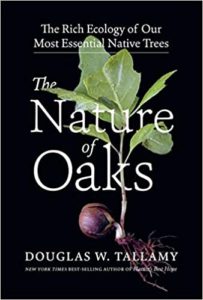 The Rich Ecology of Our Most Essential Native Trees
The Rich Ecology of Our Most Essential Native Trees
By Doug Tallamy
Published by Timber Press 2021
Reviewed by Maureen Sundberg
This past May, I mourned the loss of a huge oak tree that shaded my end of Oak Street. The neighbors were worried about their house being crushed in a storm, and though I was sympathetic to that concern, I felt a pang witnessing the gaping hole in the canopy and felt a sense of loss larger than a single tree. That loss compounded after I read Doug Tallamy’s latest book – The Nature of Oaks – and was introduced to the multitude of creatures that were dependent on that oak tree and called it home, some for a season, others for a single day.
In The Nature of Oaks, Tallamy hopes to encourage appreciation of the diversity in the web of life by focusing on a single tree that began as an acorn that he planted in a pot, transplanted into his yard, and watched for 18 years – a short amount of time, given that oak trees can live hundreds of years. This tree became the subject of Tallamy’s “oak-watching,” and he uses it to shine a light on just a few of the myriad ecological connections in an oak community. By training his attention as an ecologist on one relatively small tree, he reveals the wealth of life an oak tree sustains – not just the larger mammals and birds that we easily recognize and see feasting on acorns – but the huge variety of life that relies on Quercus species throughout the year.
Each chapter of the book focuses on one month. Tallamy begins his account in October when acorns are plentiful, and there’s lots of activity as squirrels and blue jays collect and store nuts for the winter. A chapter begins with a photo of the tree and includes interesting observations and facts about oak trees (e.g., oaks evolved with jay birds over 60 million years ago and have both been in the “new world” for the last 30 million years). We learn about just a few species observed on or around an oak tree in a given month.
With his expansive knowledge of ecology and enthusiasm for his subject, Tallamy provides a very readable account. From galls in November to polyphemus moth cocoons in April to walking sticks in September, we learn details about some of the creatures hosted by oak trees. Photos give us an up-close view so that we can take a turn at oak-watching.
Interspersed through the months, Tallamy points out several ecological mysteries relating to oak trees: How can oak saplings appear a mile from the nearest acorn-producing tree? Why do oaks retain dead leaves through fall and into the winter (leaf marcescence)? What causes masting behavior (a periodic phenomenon when populations of oak trees coordinate production of an exceptionally large crop of acorns in a single year)?
Following 12 months of his observations, Tallamy provides a guide to planting trees and a list of the oak options best suited for different parts of the continental U.S. The overarching goal of the book is to encourage everyone to plant an oak tree. Personally, I’ve gained a new appreciation for the many tiny oak trees that pop up around my yard. I’ll continue to pull up some, but others I’ll let grow or transplant to a wooded edge where I hope to protect them from deer until they can offer shelter and sustenance to their own oak communities.
The view of oak trees and ecology through Tallamy’s eyes is fascinating as we learn about a tiny slice of the life found in, around, and under a single tree. Over the next 12 months, when I have my binoculars out to check on a bird, I’ll also pull out my copy of The Nature of Oaks and scan the oak tree where the bird is perched. With Tallamy’s book as a guide, I hope to be rewarded with a glimpse of some of the tree’s smaller but equally important and interesting visitors.

 The Rich Ecology of Our Most Essential Native Trees
The Rich Ecology of Our Most Essential Native Trees